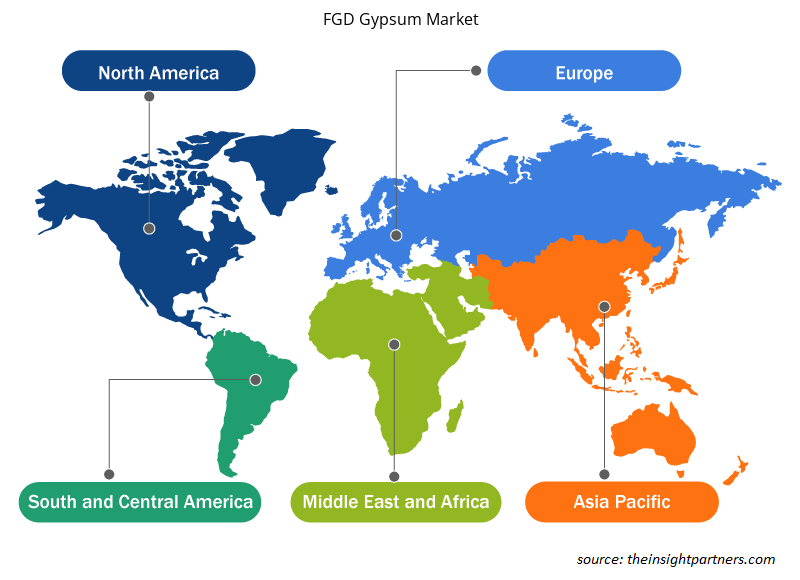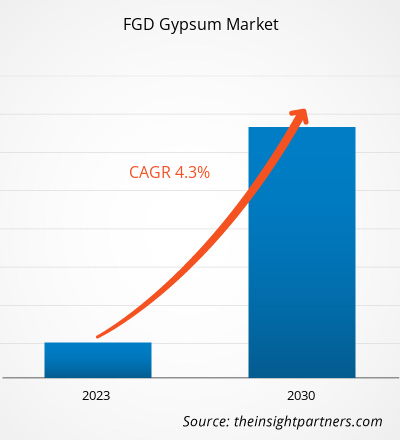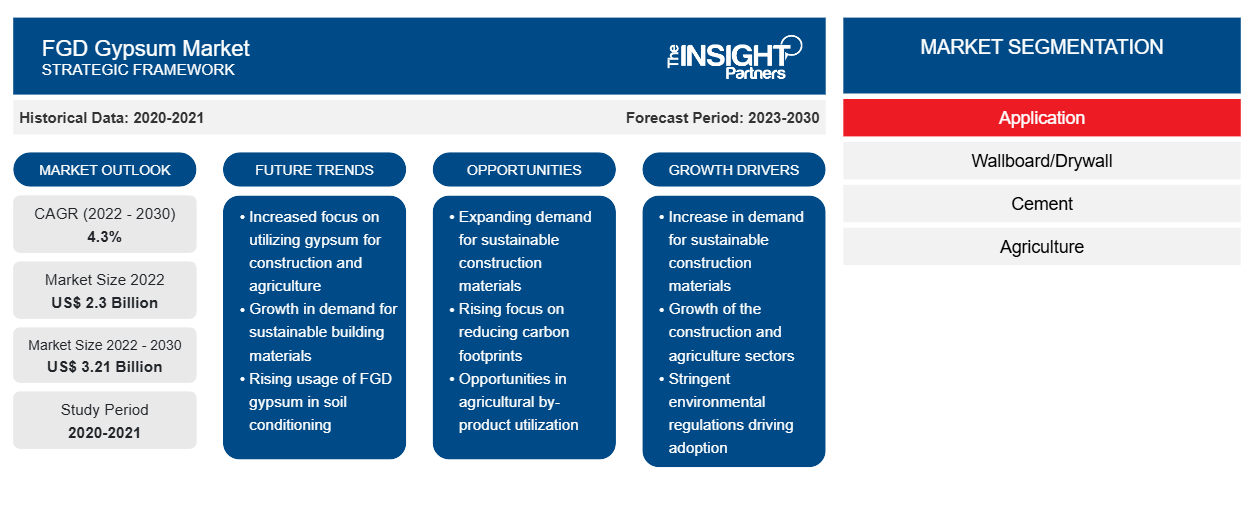[Rapporto di ricerca] Si prevede che il mercato del gesso FGD crescerà da 2.298,56 milioni di dollari nel 2022 a 3.207,00 milioni di dollari entro il 2030; si stima che registrerà un CAGR del 4,3% dal 2022 al 2030.
Approfondimenti di mercato e punto di vista degli analisti:
Il gesso FGD è un sottoprodotto generato dal processo di desolforazione del gas combustibile (FGD) nelle centrali elettriche a carbone. Questo processo viene utilizzato per rimuovere le emissioni di anidride solforosa (SO2) dai gas combustibili per rispettare le normative ambientali. Il gesso FGD è un materiale prezioso in quanto può essere utilizzato come sostituto del gesso naturale in varie applicazioni. Il settore edile, in particolare, è un importante consumatore di gesso FGD in quanto viene utilizzato nella produzione di cartongesso e cemento. Le severe normative ambientali e gli standard sulle emissioni hanno portato le centrali elettriche ad adottare sistemi FGD, con conseguente maggiore produzione di gesso FGD.
Fattori di crescita e sfide:
Il gesso viene utilizzato nel settore edile come riempitivo per cemento e intonaci per aumentarne la resistenza riducendo al contempo il tempo di presa del calcestruzzo. Il gesso FGD, un gesso sintetico, è altamente preferito per il suo impatto sul ciclo di vita inferiore rispetto al gesso naturale. Viene anche utilizzato per realizzare pannelli decorativi, pannelli per cartongesso, pannelli per cartongesso e pannelli in gesso. La crescente domanda di questi pannelli nel settore edile rafforza la domanda di gesso. Inoltre, un pannello in gesso, noto anche come pannello per cartongesso, è preferito all'intonaco poiché è più facile da installare e riparare, meno costoso e più durevole. Richiede meno tempo per il montaggio ed è anche ampiamente disponibile. Le proprietà ignifughe e la fattibilità dell'utilizzo sono fattori comuni che aumentano l'uso del gesso nelle attività di costruzione residenziali e non residenziali. I pannelli in gesso sono ampiamente utilizzati come sostituti dei pannelli in legno e delle pareti in cemento negli edifici e negli interni moderni, poiché possono essere installati facilmente e rapidamente. Tuttavia, il gesso naturale e il gesso sintetico come citrogesso, fluorogesso, fosfogesso e titanogesso sono materiali alternativi al gesso FGD. L'economicità del gesso naturale dovuta all'elevata produzione nelle maggiori regioni produttrici di gesso può avere un impatto negativo sulla preferenza per il gesso FGD per le applicazioni di cartongesso. Questo fattore riduce il consumo di gesso FGD.
Personalizza questo report in base alle tue esigenze
Riceverai la personalizzazione gratuita di qualsiasi report, comprese parti di questo report, o analisi a livello nazionale, pacchetto dati Excel, oltre a usufruire di grandi offerte e sconti per start-up e università
-
Scopri le principali tendenze di mercato in questo rapporto.Questo campione GRATUITO includerà analisi di dati che spaziano dalle tendenze di mercato alle stime e alle previsioni.
Segmentazione e ambito del report:
Il " mercato globale del gesso FGD " è segmentato in base all'applicazione. In base all'applicazione, il mercato è segmentato in cartongesso/cartongesso, cemento, agricoltura, trattamento delle acque e altri. Il mercato del gesso FGD, per area geografica, è segmentato in Nord America (Stati Uniti, Canada e Messico), Europa (Germania, Francia, Italia, Regno Unito, Russia e resto d'Europa), Asia Pacifico (Australia, Cina, Giappone, India, Corea del Sud e resto dell'Asia Pacifico), Medio Oriente e Africa (Sudafrica, Arabia Saudita, Emirati Arabi Uniti e resto del Medio Oriente e Africa) e Sud e Centro America (Brasile, Argentina e resto del Sud e Centro America)
Analisi segmentale:
In base all'applicazione, il mercato del gesso FGD è segmentato in cartongesso/cartongesso, cemento, agricoltura, trattamento delle acque e altri. Il segmento cartongesso/cartongesso ha detenuto la quota maggiore nel 2022. Il cartongesso o cartongesso è un materiale da costruzione utilizzato come alternativa ai tradizionali muri in mattoni/pietra. Il gesso FGD è ampiamente utilizzato sotto forma di cartongesso e cartongesso nel settore edile. È utilizzato come ingrediente principale per pannelli in cartongesso a base di gesso. Il nucleo del cartongesso fornisce resistenza strutturale, pur essendo anche leggero. Il gesso FGD contiene tracce di solfato di calcio emiidrato, che contribuisce alle proprietà ignifughe. Il gesso FGD è noto per la qualità e la purezza costanti, il che è vantaggioso per la produzione di cartongesso. I produttori di cartongesso e cartongesso hanno aumentato l'utilizzo di gesso sintetico come il gesso FGD come alternativa efficace al gesso naturale. Tutti questi fattori stanno stimolando il mercato globale del gesso FGD.
Analisi regionale:
In base alla geografia, il mercato del gesso FGD è segmentato in cinque regioni chiave: Nord America, Europa, Asia Pacifico, America meridionale e centrale e Medio Oriente e Africa. L'Asia Pacifico ha dominato il mercato globale del gesso FGD e il mercato regionale ha rappresentato oltre 1,3 miliardi di dollari USA nel 2022. L'Asia Pacifico è un importante contributore al mercato globale. Si prevede che l'America meridionale e centrale registrerà il CAGR più elevato di oltre il 7% durante il periodo di previsione. Il mercato del gesso FGD in America meridionale e centrale è segmentato in Brasile, Argentina e resto dell'America meridionale e centrale. Uno dei principali fattori che rafforzano la crescita del mercato in questa regione è l'aumento delle attività di costruzione. Secondo gli Stati Uniti e il Brazilian Green Building Council, il Brasile ha rappresentato oltre 1,2 milioni di metri quadrati di edifici certificati, classificandosi così al settimo posto nelle registrazioni Leadership in Energy and Environmental Design (LEED) a livello mondiale nel 2021. Secondo l'International Trade Administration, il governo argentino si concentra su progetti infrastrutturali nell'ordine dei 20 milioni di dollari USA. Pertanto, si prevede che l'aumento delle attività di costruzione stimolerà l'espansione del mercato del gesso FGD nei prossimi anni. Si prevede che anche il Nord America assisterà a una crescita considerevole, raggiungendo oltre 500 milioni di dollari entro il 2030.
Sviluppi del settore e opportunità future:
Di seguito sono elencate le varie iniziative intraprese dai principali attori operanti nel mercato del gesso FGD:
- Nel 2022, Georgia-Pacific LLC ha investito circa 300 milioni di $ USA nello stabilimento di cartongesso di Sweetwater East, Texas. L'azienda mirava a rafforzare la propria capacità di soddisfare le crescenti esigenze dei settori edilizi residenziali, commerciali e industriali in Texas.
- Nel 2022, Adaptavate Ltd ha lanciato cartongesso realizzato con scarti agricoli e un legante a base di calce che assorbe l'anidride carbonica. L'approccio ha eliminato la necessità di gesso, un materiale ad alta intensità di emissioni. L'azienda ha raccolto 2,9 milioni di dollari USA per lo sviluppo di una linea pilota a Bristol, in Inghilterra, volta a produrre questi pannelli in cartongesso standard del settore.
Approfondimenti regionali sul mercato del gesso FGD
Le tendenze regionali e i fattori che influenzano il mercato del gesso FGD durante il periodo di previsione sono stati ampiamente spiegati dagli analisti di Insight Partners. Questa sezione discute anche i segmenti e la geografia del mercato del gesso FGD in Nord America, Europa, Asia Pacifico, Medio Oriente e Africa e America meridionale e centrale.

- Ottieni i dati specifici regionali per il mercato del gesso FGD
Ambito del rapporto di mercato del gesso FGD
| Attributo del report | Dettagli |
|---|---|
| Dimensioni del mercato nel 2022 | 2,3 miliardi di dollari USA |
| Dimensioni del mercato entro il 2030 | 3,21 miliardi di dollari USA |
| CAGR globale (2022-2030) | 4,3% |
| Dati storici | 2020-2021 |
| Periodo di previsione | 2023-2030 |
| Segmenti coperti |
Per applicazione
|
| Regioni e Paesi coperti |
America del Nord
|
| Leader di mercato e profili aziendali chiave |
|
Densità dei giocatori del mercato del gesso FGD: comprendere il suo impatto sulle dinamiche aziendali
Il mercato del gesso FGD sta crescendo rapidamente, spinto dalla crescente domanda degli utenti finali dovuta a fattori quali l'evoluzione delle preferenze dei consumatori, i progressi tecnologici e una maggiore consapevolezza dei vantaggi del prodotto. Con l'aumento della domanda, le aziende stanno ampliando le loro offerte, innovando per soddisfare le esigenze dei consumatori e capitalizzando sulle tendenze emergenti, il che alimenta ulteriormente la crescita del mercato.
La densità degli operatori di mercato si riferisce alla distribuzione di aziende o società che operano in un particolare mercato o settore. Indica quanti concorrenti (operatori di mercato) sono presenti in un dato spazio di mercato in relazione alle sue dimensioni o al valore di mercato totale.
Le principali aziende che operano nel mercato del gesso FGD sono:
- Georgia-Pacific LLC
- Cez Energeticke Produkty SRO
- EP Power Minerals GmbH
- CASEA GmbH
- Società Holcim
Disclaimer : le aziende elencate sopra non sono classificate secondo un ordine particolare.

- Ottieni una panoramica dei principali attori del mercato del gesso FGD
Impatto del COVID-19:
La pandemia di COVID-19 ha avuto effetti negativi su quasi tutti i settori in vari paesi. I lockdown, le restrizioni di viaggio e le chiusure delle attività in Nord America, Europa, Asia Pacifico (APAC), Sud e Centro America (SAM) e Medio Oriente e Africa (MEA) hanno ostacolato la crescita di diversi settori, tra cui l'industria chimica e dei materiali. La chiusura delle unità produttive ha disturbato le catene di fornitura globali, le attività di produzione, i programmi di consegna e le vendite di prodotti essenziali e non essenziali. Diverse aziende hanno segnalato ritardi nelle consegne dei prodotti e un crollo delle vendite dei loro prodotti nel 2020. A causa della recessione economica indotta dalla pandemia, i consumatori sono diventati cauti e selettivi nelle decisioni di acquisto. Gli acquisti non essenziali sono stati significativamente ridotti dai consumatori a causa di redditi più bassi e prospettive di guadagno incerte, soprattutto nelle regioni in via di sviluppo. Molti produttori di gesso FGD hanno segnalato un calo dei profitti a causa della ridotta domanda dei consumatori durante la fase iniziale della pandemia. Tuttavia, entro la fine del 2021, molti paesi erano completamente vaccinati e i governi hanno annunciato un allentamento di alcune normative come i lockdown e i divieti di viaggio. Le persone hanno iniziato a viaggiare in luoghi diversi, il che ha aumentato la domanda di gesso FGD. Tutti questi fattori hanno avuto un impatto positivo sulla crescita del mercato del gesso FGD in diverse regioni.
Scenario competitivo e aziende chiave:
Georgia-Pacific LLC, Cez Energeticke Produkty SRO, EP Power Minerals GmbH, CASEA GmbH, Holcim Ltd, Knauf Gips KG, Travancore Titanium Products Ltd, Compagnie de Saint-Gobain SA, American Gypsum Co LLC e National Gypsum Co sono tra i principali attori che operano nel mercato globale del gesso FGD. Gli attori offrono gesso FGD di alta qualità e soddisfano le esigenze di molti consumatori nel mercato globale.
- Analisi storica (2 anni), anno base, previsione (7 anni) con CAGR
- Analisi PEST e SWOT
- Valore/volume delle dimensioni del mercato - Globale, Regionale, Nazionale
- Industria e panorama competitivo
- Set di dati Excel
Report recenti
Testimonianze
Motivo dell'acquisto
- Processo decisionale informato
- Comprensione delle dinamiche di mercato
- Analisi competitiva
- Analisi dei clienti
- Previsioni di mercato
- Mitigazione del rischio
- Pianificazione strategica
- Giustificazione degli investimenti
- Identificazione dei mercati emergenti
- Miglioramento delle strategie di marketing
- Aumento dell'efficienza operativa
- Allineamento alle tendenze normative























 Ottieni un campione gratuito per - Mercato del gesso FGD
Ottieni un campione gratuito per - Mercato del gesso FGD